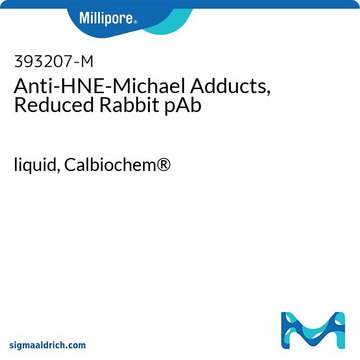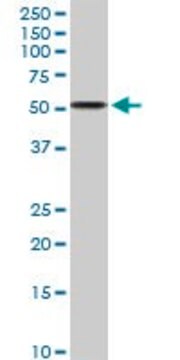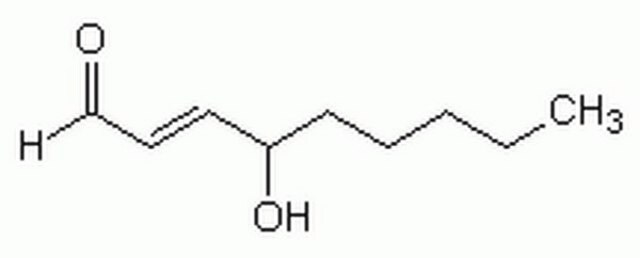ABN249
Anti-HNE Michael Adducts Antibody, Reduced
serum, from rabbit
Synonym(s):
Reduced 4-hydroxy-trans-2-nonenal Michael adducts, Reduced HNE Michael adducts
About This Item
Recommended Products
biological source
rabbit
Quality Level
antibody form
serum
antibody product type
primary antibodies
clone
polyclonal
species reactivity
bovine, human
technique(s)
western blot: suitable
shipped in
ambient
target post-translational modification
unmodified
General description
Specificity
Immunogen
Application
1. ABN249 replaces Calbiochem 393207. ABN249 is expected to work in immunocytochemistry and immunohistochemistry. Please refer to the following 393207 citations as examples of sample preparations and detection in these two types of applications:
Usatyuk, P.V., et al. (2006). J. Biol. Chem. 281(46):35554-35566 (Immunocytochemistry).
McCormack, A.L., et al. (2005). J. Neurochem. 93(4):1030-1037 (Immunohistochemistry).
2. Anti-HNE Fluorophore, Cat. No. 393206, is also available for the detection of HNE Fluorophore by ELISA, Immunohistochemistry, and Western blotting.
3. To generate a positive control for Western blotting, treat a 2 mg/mL BSA solution in 10 mM KH2PO4, pH 7.4, with 0.1 to 0.5 mM HNE and incubate for 1 hr at 37°C. The reaction can be monitored by the decrease of HNE absorbance at 224 nm (extinction coefficient 13,750/M). Free HNE can be removed by gel filtration and dialysis following the chemical reaction.
HNE Michael adducts in protein solutions must be chemically reduced by sodium borohydride (NaBH4) prior to analysis using ABN1348. A freshly prepared 100 mM NaBH4 solution in 1 mM NaOH is added 1:9 (V:V) to the protein sample solution to a final NaBH4 concentration of 10 mM. The protein solution is kept at room temperature for 10 to 30 min prior to quenching with the addition of 5 to 10 molar equivalents of acetone.
Quality
Western Blotting Analysis: A 1:10,000 of this antibody detected 10 ng of HNE-modified BSA only after, but not before, reduction by sodium borohydride.
Target description
Linkage
Analysis Note
HNE-modifed BSA chemically reduced by sodium borohydride.
Other Notes
Not finding the right product?
Try our Product Selector Tool.
Storage Class
12 - Non Combustible Liquids
wgk_germany
WGK 1
flash_point_f
Not applicable
flash_point_c
Not applicable
Certificates of Analysis (COA)
Search for Certificates of Analysis (COA) by entering the products Lot/Batch Number. Lot and Batch Numbers can be found on a product’s label following the words ‘Lot’ or ‘Batch’.
Already Own This Product?
Find documentation for the products that you have recently purchased in the Document Library.
Our team of scientists has experience in all areas of research including Life Science, Material Science, Chemical Synthesis, Chromatography, Analytical and many others.
Contact Technical Service







